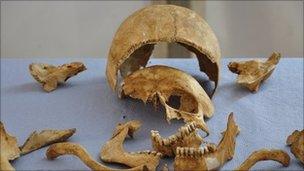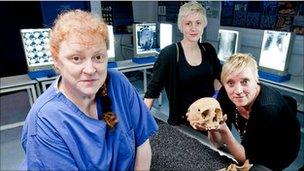York mass grave skeletons were Civil War soldiers
- Published

The remains showed no signs of an obvious cause of death
Mass graves found in York contained the skeletons of English Civil War soldiers, according to a new investigation.
Mass graves containing 113 male skeletons were unearthed just outside the city walls in 2008.
It is thought the men had fought for the Parliamentarians during the siege of York in 1644.
An investigation for the BBC series History Cold Case has concluded the men probably died from typhus fever.
The programme features a team from the Centre of Anatomy and Human Identification at the University of Dundee.
Their examination of the bodies showed clear signs of broken bones and serious infections, but no signs of an obvious cause of death.
The location the graves were discovered in pointed to a burial at some point during the 17th Century.
As a result, the team believe the bodies were buried during the war between King Charles I and the supporters of Parliament in the 1640s.
Merchant seamen
York was the key to controlling the north of England during the war and the city was besieged by Parliamentarian forces under Lord Fairfax during the spring of 1644.
The mass graves were found on the side of the city walls where Lord Fairfax's forces were camped.
Further tests revealed the men would have had a diet that was high in seafood.
Civil War experts confirmed that a large proportion of the Parliamentarian army besieging York came from Hull.
A large merchant fleet operated out of the Yorkshire port and many of the seamen volunteered to fight for Parliament.

Two sets of remains intrigued the team as they showed signs of severe disfigurement.
These men did not die in battle though.
Team leader, forensic anthropologist Professor Sue Black, said: "It is reasonable to expect these were fighting men but we don't find trauma giving us evidence of how these men died.
"What we do know is that more people died in this conflict because of disease."
The team believe typhus fever, which was common, highly contagious and would have caused no long-lasting trauma to the bones, was the likeliest cause of death.
Severe disfigurement
Among the skeletons were two sets of remains which showed signs of severe disfigurement.
The hand bones of one were fused together while the second had more severe bone fusions in an arm and leg.
This rare disability is a genetically linked abnormality but the DNA was not of high enough quality to determine whether they were related.
Professor Sue Black said: "It is possible that they could still be related, we just can't show it.
"I think the chances of having this condition in individuals who are not related and are in pretty much the same grave at the same time would be stretching it a bit far."
Graham Bruce, the local archaeologist who supervised the initial excavation, said: "This investigation really fleshes out those people that we're dealing with during that quite tumultuous period of English history."
History Cold Case: The York 113 will be shown on BBC Two at 2100 BST on Thursday 7 July 2011 and later in the UK on BBC iPlayer.
- Published27 June 2011